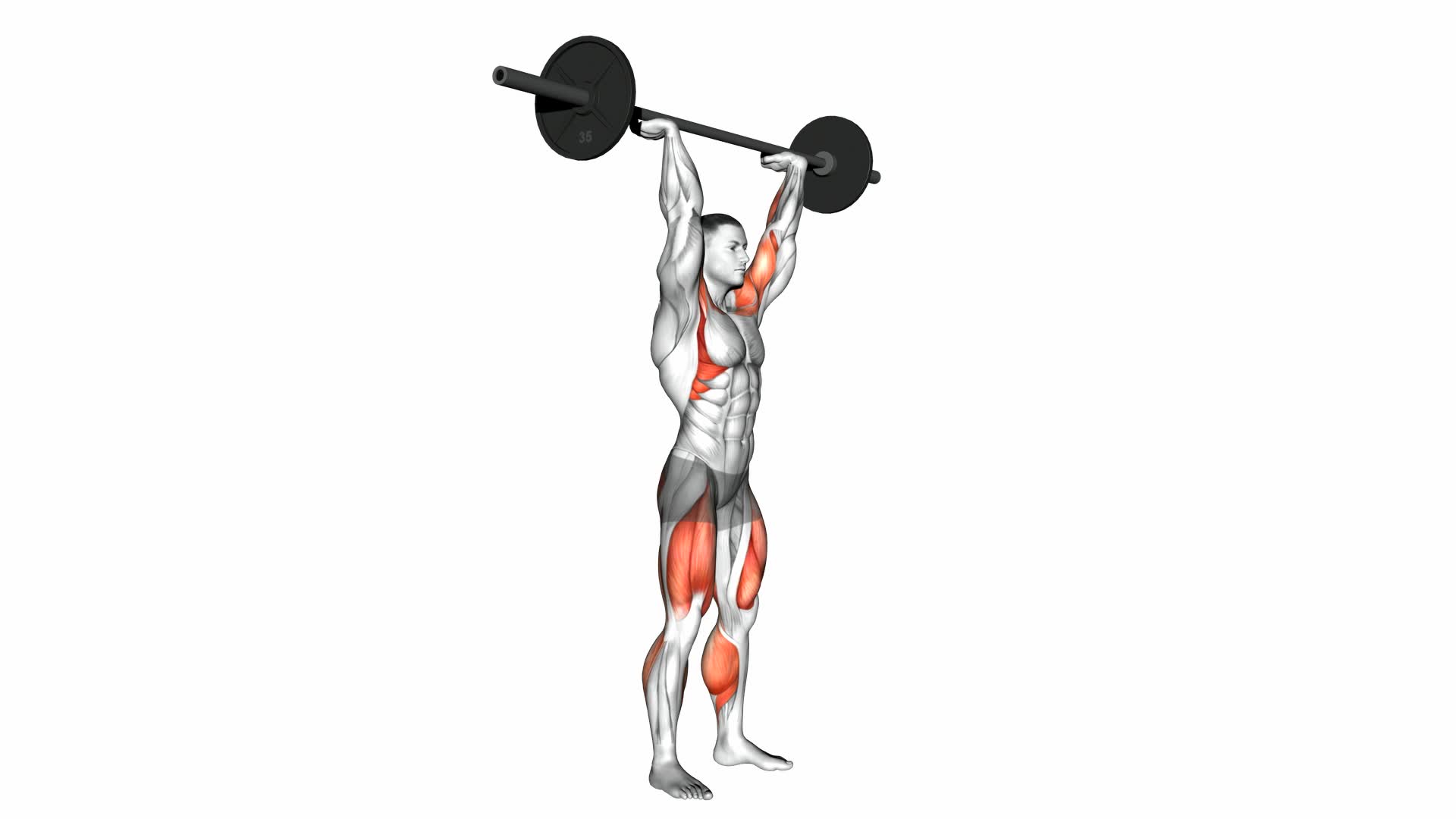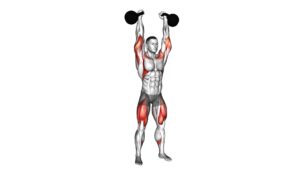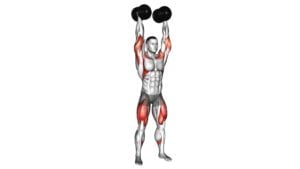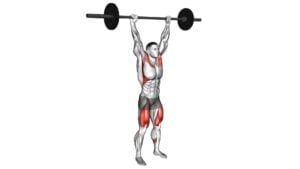Push Press – Video Exercise Guide & Tips

Looking to build strength and power in your upper body? Check out the Push Press – Video Exercise Guide & Tips!
Watch This Exercise Video
This comprehensive guide will walk you through the proper technique, common mistakes to avoid, and variations to challenge yourself.
With easy-to-follow videos, you'll be able to master this exercise in no time.
Elevate your fitness routine and maximize your gains with the Push Press!
Key Takeaways
- Push press targets multiple muscle groups
- Proper grip and stance are important for the push press
- Hip drive is crucial for generating explosive power
- Avoiding overextension helps reduce the risk of injury
Benefits of the Push Press
You can maximize your strength and power by incorporating the push press into your workout routine. The push press is a compound exercise that targets multiple muscle groups, making it an effective choice for weightlifters. One of the benefits of the push press is its ability to improve upper body strength. By engaging the shoulders, triceps, and chest, this exercise helps to build strong and defined muscles in these areas. Additionally, the push press also works the lower body, specifically the quadriceps and glutes, as they're engaged to generate power and propel the weight overhead.
Another advantage of the push press is its versatility. There are various push press variations that can be incorporated into your training program to keep things interesting and prevent plateaus. For example, you can perform the push press with dumbbells, barbells, or kettlebells, each providing a slightly different challenge and targeting different stabilizing muscles.
Furthermore, the push press is a functional movement that translates well to real-life activities. The explosive nature of the exercise mimics movements like throwing or pushing heavy objects, making it beneficial for athletes and individuals involved in sports or physical labor. By regularly incorporating the push press into your weightlifting routine, you can improve your overall strength, power, and athleticism.
Proper Technique for the Push Press
To perform the push press with proper technique, there are three key points to focus on: grip and stance, hip drive importance, and avoiding overextension.
First, ensure that you have a solid grip on the barbell and that your feet are shoulder-width apart.
Next, engage your hips to generate power and explosively drive the barbell overhead.
Grip and Stance
Ensure proper grip and stance for optimal technique in the push press by positioning your hands just outside shoulder-width apart and your feet hip-width apart. To help you understand the importance of grip strength and foot positioning, here are four key points to consider:
- Grip Strength: A strong grip allows you to securely hold the barbell throughout the movement, preventing it from slipping or causing discomfort.
- Hand Placement: Positioning your hands just outside shoulder-width apart allows for a stable base and optimal control of the barbell during the push press.
- Foot Positioning: Placing your feet hip-width apart ensures a solid foundation and helps generate power from the lower body during the upward drive of the movement.
- Balance and Stability: Proper foot positioning, along with a strong grip, helps maintain balance and stability throughout the push press, reducing the risk of injury and enabling you to lift heavier weights.
Hip Drive Importance
To perform the push press with proper technique, it's crucial to consistently engage your hips in driving the upward movement. The hip drive plays a vital role in generating the explosive power needed for a successful push press.
By forcefully extending your hips, you transfer the power from your lower body to your upper body, allowing you to lift heavier weights. This explosive power is essential in Olympic weightlifting, where speed and strength are paramount.
Incorporating the push press into your training routine can help improve your overall performance in Olympic weightlifting, as it trains your body to generate power from the hips and transfer it through the entire body.
Remember to focus on maintaining a strong and stable core while utilizing the hip drive for maximum effectiveness.
Avoiding Overextension
Engage your core and maintain proper body alignment to avoid overextension while performing the push press. Overextending your back during the push press can lead to strain and potential injury. To prevent this, follow these tips:
- Keep your core tight: Engage your abdominal muscles throughout the movement to provide stability and support for your spine.
- Maintain a neutral spine: Avoid arching your lower back or excessively leaning backward. Keep your spine in a straight line from your head to your tailbone.
- Control the movement: Avoid using momentum to lift the weight overhead. Instead, focus on using your legs and hips to generate power and drive the weight upward.
- Modify as needed: If you find it challenging to maintain proper form, consider using lighter weights or performing a modified version of the exercise.
By following these guidelines, you can perform the push press safely and effectively, reducing the risk of injury.
Now, let's move on to the next section about common mistakes to avoid.
Common Mistakes to Avoid
Avoid leaning too far forward during the push press exercise, as this can compromise your form and decrease the effectiveness of the movement. One of the most common mistakes people make when performing the push press is leaning excessively forward. This can happen when you try to generate more power by using your lower back instead of your legs and shoulders. Leaning forward not only puts unnecessary strain on your back, but it also takes away from the intended benefits of the exercise.
To avoid this mistake, make sure to maintain an upright posture throughout the movement. Keep your chest up, shoulders back, and core engaged. As you initiate the push press, focus on driving through your legs and using the power from your lower body to propel the weight overhead. By doing this, you won't only protect your back but also maximize the effectiveness of the exercise.
Now that you understand the common mistake to avoid during the push press, let's move on to the next section, which covers the equipment and set-up for this exercise. Proper equipment and set-up are crucial to ensure safety and optimal performance during the push press.
Equipment and Set-Up for the Push Press
To perform the push press, you'll need either a barbell or dumbbells. The choice is yours based on your preference and the equipment available to you.
When setting up for the push press, ensure that the barbell or dumbbells are placed in the proper rack position, allowing you to easily and safely lift the weight overhead.
Barbell or Dumbbells
You can choose between using a barbell or dumbbells as your equipment for the push press exercise. Both options have their own advantages and considerations. Here are four key factors to consider when deciding which equipment to use:
- Barbell vs. Dumbbells: The barbell allows for heavier loads, making it ideal for building strength and power. Dumbbells, on the other hand, provide greater stability and allow for better isolation of individual limbs.
- Equipment Availability: Gym environments typically have barbells readily available, while dumbbells may be limited in quantity. Consider the availability of equipment when planning your workout.
- Training Goals: If you're an athlete looking to improve explosive power and enhance sports performance, the barbell push press is a great choice. Dumbbells can provide more variation and target specific muscles for bodybuilding or rehabilitation purposes.
- Skill Level: Beginners may find it easier to learn and perform the push press with dumbbells, as they allow for better control and coordination. Barbell push presses require proper technique and stability to avoid injury.
Consider these factors to determine which equipment is most suitable for your needs and goals.
Proper Rack Positioning
When selecting the proper rack positioning for the push press exercise, ensure that the barbell or dumbbells are securely placed on your shoulders, resting comfortably on your upper chest and collarbone. This rack position is vital for the correct execution of the push press as it allows for maximum power generation and stability.
By positioning the weight in this way, you create a strong foundation and minimize the risk of injury. The benefits of maintaining proper rack position include improved shoulder stability, increased upper body strength, and enhanced overall performance.
Additionally, the rack position allows for various push press variations, such as the single-arm push press or the kettlebell push press. These variations provide an opportunity to target different muscles and add variety to your training routine.
Now that you understand the importance of proper rack positioning, let's explore the different variations and progressions for the push press.
Variations and Progressions for the Push Press
As you progress in your push press training, incorporating variations can help challenge your muscles and enhance overall strength and power.
Here are four variations and progressions to take your push press to the next level:
- Single Leg Push Press: Perform the push press while standing on one leg. This variation engages your core and improves balance and stability.
- Dumbbell Push Press: Instead of using a barbell, use dumbbells for the push press. This variation increases the demand on each arm individually and improves coordination.
- Depth Push Press: Start the push press from a deeper squat position, increasing the range of motion and targeting your legs and glutes even more.
- Push Press with Resistance Bands: Attach resistance bands to the barbell or dumbbells and perform the push press. The bands provide accommodating resistance, challenging your muscles throughout the entire movement.
Incorporating these variations and progressions into your push press training can help prevent plateaus, keep your workouts exciting, and continuously challenge your muscles.
Remember to always maintain proper form and gradually increase the difficulty as you become more comfortable with each variation.
Sample Push Press Workout Routine
To continue challenging your muscles and enhancing overall strength and power, incorporate the following sample push press workout routine into your training regimen.
The push press is a highly effective exercise for strength training, as it targets multiple muscle groups, including the shoulders, triceps, and legs.
Begin the workout by performing three sets of eight repetitions of the standard push press exercise. Start with a weight that allows you to maintain proper form and gradually increase the weight as you become more comfortable with the movement. Rest for one to two minutes between sets to allow for recovery.
Next, incorporate some variations of the push press to further engage different muscle fibers. Try performing three sets of eight repetitions of the dumbbell push press, using dumbbells instead of a barbell. This will challenge your stability and increase muscle activation.
To target your legs and glutes, include three sets of eight repetitions of the squat push press. Start in a squat position and explode upward, using the momentum to perform the push press.
Finish the workout with three sets of eight repetitions of the single-arm kettlebell push press on each arm. This exercise will help improve stability and balance.
Remember to always use proper form and technique during each exercise. And don't forget to warm up and stretch before starting the workout to prevent injuries.
Incorporate this sample push press workout routine into your training regimen to enhance your strength and power.
Frequently Asked Questions
How Many Reps and Sets Should I Do for the Push Press Exercise?
To determine the number of reps and sets for the push press exercise, it's important to consider your fitness level and goals.
For beginners, it's recommended to start with 2-3 sets of 8-10 reps.
As you progress, you can increase the number of sets or reps to challenge yourself.
It's always a good idea to consult with a fitness professional to ensure proper form and modifications for beginners.
Can the Push Press Exercise Be Modified for Beginners?
Yes, the push press exercise can be modified for beginners.
There are several push press modifications and progressions that can help you build strength and improve your technique.
Start with lighter weights and focus on mastering the proper form before adding more weight.
You can also try using a resistance band or performing the exercise with dumbbells instead of a barbell.
Remember to listen to your body and start at a level that's challenging but manageable for you.
Is the Push Press Exercise Suitable for Individuals With Shoulder Injuries?
If you have shoulder injuries, the push press exercise may not be suitable for you. It's important to focus on rehabilitation exercises that target your shoulder and promote healing.
Instead of the push press, you can try alternative exercises that put less strain on your shoulders, such as shoulder raises or lateral raises. These exercises can still help you build strength and improve your upper body without aggravating your shoulder injuries.
Can I Incorporate the Push Press Exercise Into My Weightlifting Routine?
Yes, you can definitely incorporate the push press exercise into your weightlifting routine. It offers several benefits for weightlifting, such as increasing upper body strength and power.
By engaging your legs, core, and shoulders, the push press allows you to lift heavier weights and improve overall muscle development. It also helps with explosiveness and can enhance your performance in other compound lifts.
Just ensure proper form and gradually increase the weight to avoid injury.
How Does the Push Press Differ From Other Shoulder Exercises Like the Military Press or the Push Jerk?
The push press is a great exercise for improving overall shoulder strength and power. It differs from other shoulder exercises like the military press or push jerk because it involves a slight dip and drive from the legs to generate momentum and power the weight overhead.
This allows you to lift heavier weights and target multiple muscle groups simultaneously. To maximize results, focus on proper technique and form, ensuring you engage your core and maintain a stable upper body throughout the movement.
Conclusion
In conclusion, the push press is a highly effective exercise for building strength and power in the upper body.
By properly executing the technique and avoiding common mistakes, you can maximize the benefits of this exercise.
Additionally, variations and progressions can be incorporated to challenge yourself and continue making progress.
Incorporating the push press into your workout routine can help you achieve your fitness goals and enhance overall performance.

Author
Years ago, the spark of my life’s passion ignited in my mind the moment I stepped into the local gym for the first time. The inaugural bead of perspiration, the initial endeavor, the very first surge of endorphins, and a sense of pride that washed over me post-workout marked the beginning of my deep-seated interest in strength sports, fitness, and sports nutrition. This very curiosity blossomed rapidly into a profound fascination, propelling me to earn a Master’s degree in Physical Education from the Academy of Physical Education in Krakow, followed by a Sports Manager diploma from the Jagiellonian University. My journey of growth led me to gain more specialized qualifications, such as being a certified personal trainer with a focus on sports dietetics, a lifeguard, and an instructor for wellness and corrective gymnastics. Theoretical knowledge paired seamlessly with practical experience, reinforcing my belief that the transformation of individuals under my guidance was also a reflection of my personal growth. This belief holds true even today. Each day, I strive to push the boundaries and explore new realms. These realms gently elevate me to greater heights. The unique combination of passion for my field and the continuous quest for growth fuels my drive to break new ground.



